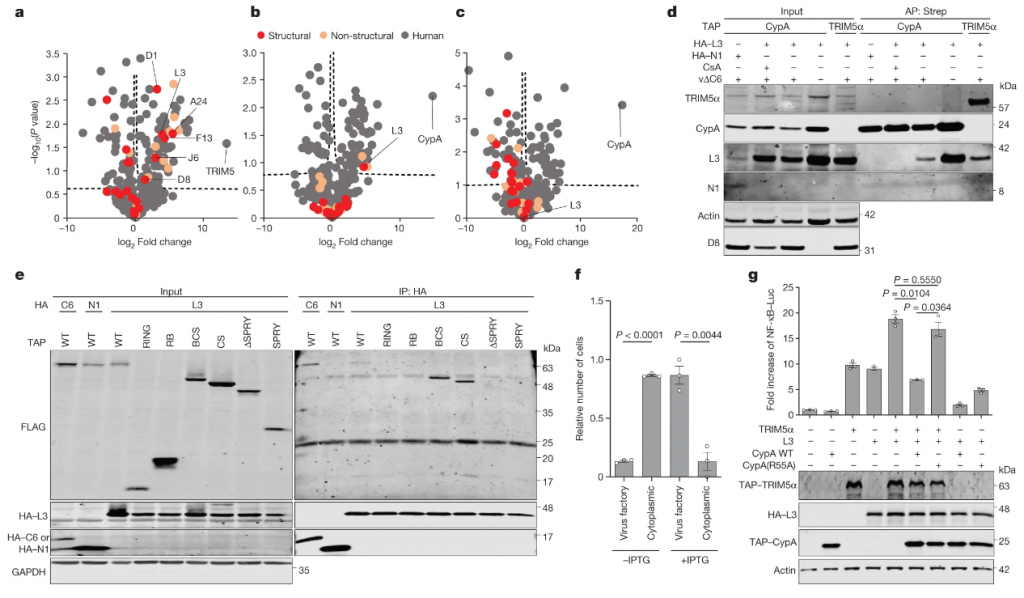In a new study, researchers from the University of Oxford, the University of Cambridge, and the Pierbright Institute in the UK have discovered a new treatment method that may be more durable than current methods when studying how the pox virus evades the natural defense function of human cells. Prior to this, they discovered how the pox virus hijacks a cellular protein to evade the host cell’s defense, thereby effectively replicating and spreading. The relevant research results were published online in the journal Nature, with the title “TRIM5α restricts poxviruses and is antagonized by CypA and the viral protein C6”.
Existing immunosuppressive drugs or drugs for treating other viral infections are targeted at these cellular proteins. In this new study, these authors found that these drugs can also limit the replication and transmission of the pox virus. In this treatment method, these drugs do not directly target the poxvirus, which means that such viruses will have a harder time evolving resistance. Due to the fact that this hijacking mechanism is the same among many poxviruses, these drugs will be effective in treating a range of diseases, such as monkeypox (caused by a poxvirus called monkeypox virus) and smallpox (caused by a poxvirus called smallpox virus).
Although smallpox was eradicated as a disease in 1979, the smallpox virus that caused it is still kept in two highly secure laboratories, one in the United States and the other in Russia. Due to the possibility of the smallpox virus being used for bioterrorism, a drug called teovirimat has been licensed to treat smallpox.
Monkeypox (caused by the monkeypox virus) is still prevalent, and although the number of infections in the UK has decreased, it still exists, especially in London and many other countries. Last year, teovirimat was used to treat severe cases of monkeypox, but this has led to the emergence of multiple resistant strains of monkeypox virus.

Professor Geoffrey L. Smith, co-author of the paper and the Department of Pathology at the University of Cambridge, the Dunn School of Pathology at the University of Oxford, and the Pierbright Institute said, “The drugs we have found may be more durable than current methods for treating monkeypox – we hope these drugs will also be effective against a range of other poxviruses, including the poxvirus that causes smallpox.”
Once the pox virus infects host cells, it must resist attacks from cellular proteins that limit virus replication and transmission. These authors have discovered that a type-specific cellular protein called TRIM5α can limit the growth of viruses, while another cellular protein called cyclophilin A (CypA) can prevent TRIM5α do this. Existing drugs target CypA, thereby making the pox virus resistant to TRIM5α more sensitive.
Smith said, “There are currently multiple drugs targeting CypA, and since many of them have already passed clinical trials, we are not starting from scratch, but rather reusing existing drugs, which is much faster.”
Many other pox viruses can also affect animals, for example, the global pandemic of “bovine nodular rash” is currently affecting cattle and may be fatal.
Smith added, “Our results were completely unexpected. We started this study because we were interested in understanding the basic science of how smallpox viruses evade host defense, and we had no idea that this could lead to drugs for treating monkeypox and other smallpox viruses.”
Professor Guy Poppy, interim executive chairman of the British Council for Biotechnology and Biosciences Research (BBSRC), said, “The establishment of this national monkeypox research alliance is driven by the urgent need for the UK to respond to the threat of new diseases caused by the monkeypox virus. It is crucial that public funders and policymakers can act flexibly and coordinate to support rapid scientific response measures.”
The science behind this discovery
The project began with a simple observation that infection with the vaccinia virus can cause TRIM5α level drops in human cells. In order to identify the cause, these authors designed a lack of TRIM5α in human cells, it was found that this virus replicates and spreads better in these cells. This indicates TRIM5α has antiviral activity.
Next, they confirmed TRIM5α targeted vaccinia virus protein. They also found that this virus has two defense measures against TRIM5a attacks: first, it uses another cell protein – Cypa – to block TRIM5α’s antiviral activity; secondly, it produces a viral protein – C6- to induce the destruction of TRIM5α.
Existing drugs target CypA. When these authors tested a series of drugs targeting CypA against a range of smallpox viruses, including the monkeypox virus, they found that they had antiviral effects in all cases. The principle of action of these drugs is to make the pox virus resistant to TRIM5α more sensitive.
Related Services
Protein Expression and Purification Services
Reference
Yiqi Zhao et al. TRIM5α restricts poxviruses and is antagonized by CypA and the viral protein C6. Nature, 2023, doi:10.1038/s41586-023-06401-0.